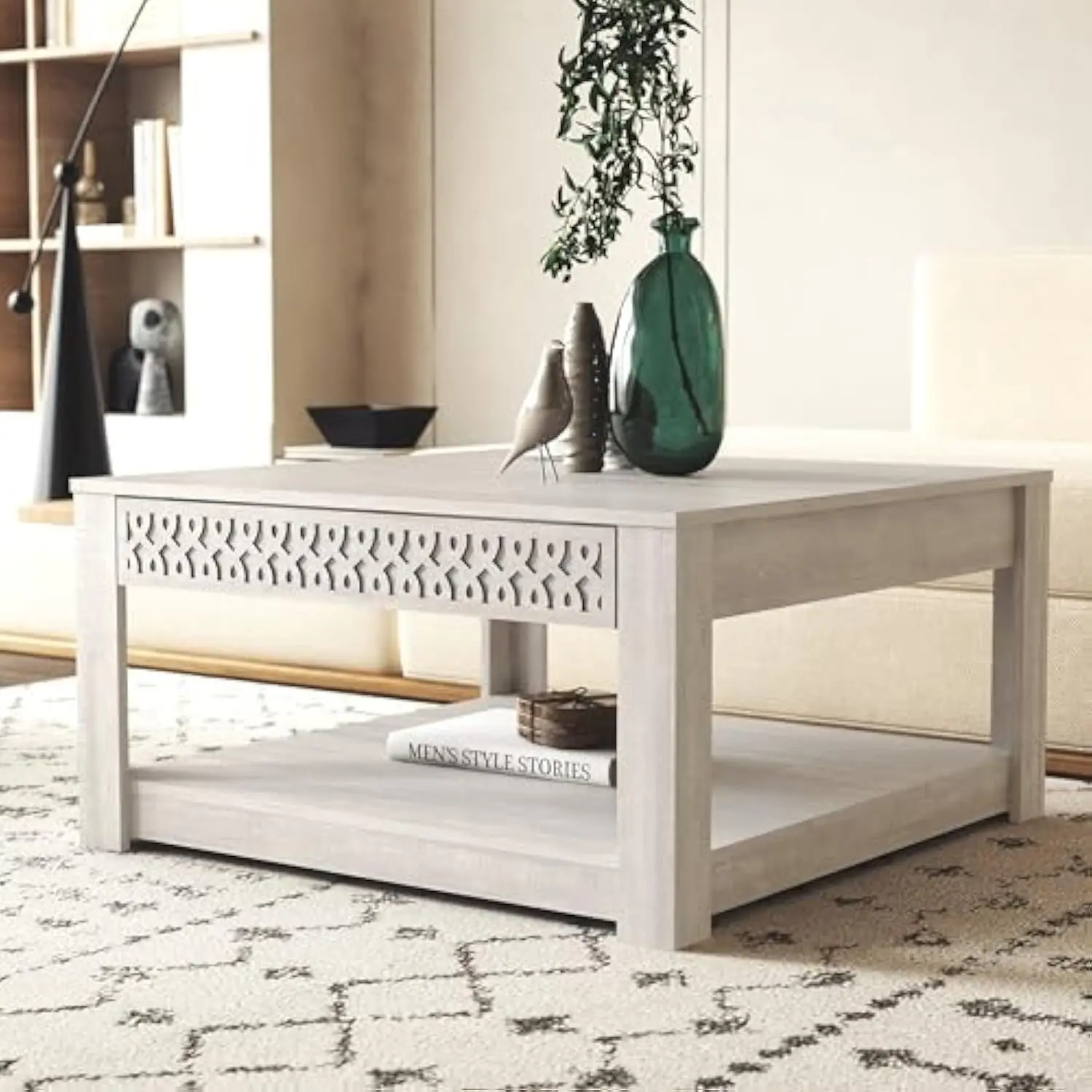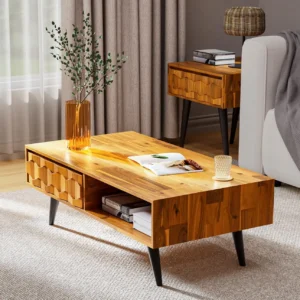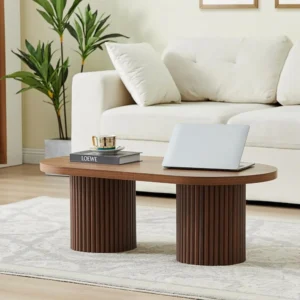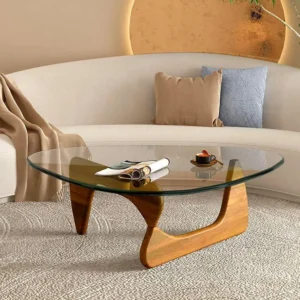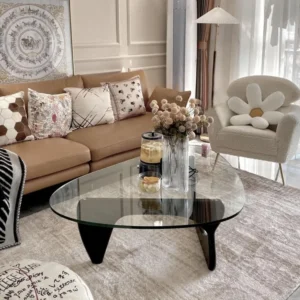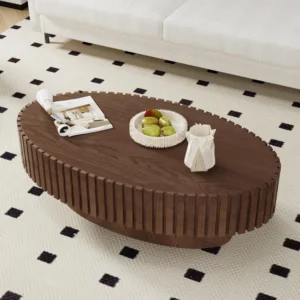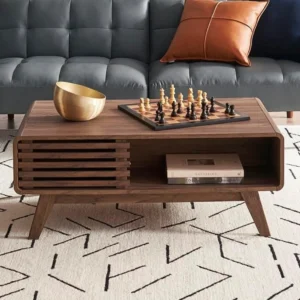Introduction: The Heritage of Danish Coffee Table Craftsmanship
The story of Danish coffee table design is one of exceptional craftsmanship passed down through generations. At its heart lies a unique philosophy blending masterful woodworking with clean functionality and minimalist beauty. Unlike mass-produced furniture, these pieces showcase meticulous construction techniques that define their character and ensure their longevity.
What truly distinguishes Danish coffee tables is how form and function merge into a seamless whole. The construction isn’t merely structural—it’s an essential part of the aesthetic appeal. This careful balance emerged from the mid-century modern movement but has transcended trends to become a timeless approach to furniture design.
The enduring value of these pieces stems directly from their construction quality. When you understand the materials, joinery techniques, and design principles behind Danish-inspired coffee table designs, you gain appreciation for why these pieces remain sought-after collector’s items and functional art.
In exploring Danish modern coffee table elements, we’ll discover how master craftspeople select premium woods, execute precise joinery, and incorporate distinctive design features—all while maintaining clean lines that define the style. These elements distinguish Danish design from other mid-century vs mid-century modern furniture approaches, creating pieces that remain relevant and beautiful decades after their creation.
Essential Materials: The Foundation of Danish Coffee Tables
Signature Woods in Danish Construction
The materials chosen for Danish coffee tables are never an afterthought—they’re fundamental to both aesthetic appeal and structural integrity. Each wood type brings distinct characteristics to the finished piece:
Teak reigns as perhaps the most iconic material in Danish coffee table construction. Its natural oils provide exceptional durability and resistance to moisture damage, making it ideal for furniture meant to last generations. The warm honey-gold color deepens beautifully with age, developing a rich patina that collectors prize. Browse our collection of mid-century modern teak coffee tables to see authentic examples of this remarkable material in use.
Rosewood represents the luxury tier of Danish design. Its dramatic grain patterns range from deep chocolate browns to vibrant purples and reds, often featuring striking black streaks. While more expensive and now more carefully sourced due to sustainability concerns, vintage rosewood pieces showcase exceptional density and a natural luster that’s impossible to replicate with lesser materials.
Oak provides tremendous structural strength with a lighter appearance than teak or rosewood. Danish craftspeople often used oak for its straight grain pattern and excellent workability. The wood’s porous nature allows it to accept stains and oils beautifully, making it versatile for various finish treatments.
Walnut offers rich chocolate tones and exceptional stability. Contemporary makers frequently choose walnut for mid-century modern walnut coffee tables that honor Danish traditions while incorporating subtle modern adaptations. The wood’s straight grain takes on a silky luster when properly finished.
Supporting Materials in Authentic Designs
While solid wood forms the primary structure, Danish coffee tables often incorporate complementary materials:
Plywood might seem surprising in premium furniture, but Danish designers embraced its stability and versatility for creating curved forms and ensuring tabletops resist warping. Quality plywood with teak or rosewood veneers allowed designers to maximize the visual impact of precious woods while maintaining structural integrity.
Glass adds visual lightness and functional practicality to many Danish designs. The transparency creates a floating effect that enhances the sculptural quality of wooden elements. Explore our mid-century modern glass top coffee tables to see how this material complements wooden structures.
Metal components—usually brass or stainless steel—appear strategically in hardware, leg ferrules, or as subtle accents. These elements provide both structural reinforcement and visual contrast to the warm wood tones.
Traditional Finishes for Protection and Beauty
Danish furniture finishing emphasizes enhancing rather than concealing the wood’s natural beauty:
Danish oil penetrates deep into the wood fibers rather than creating a surface film. This approach highlights the natural grain while providing protection from within. Multiple thin coats build up to a soft luster that feels natural to the touch.
Tung oil offers superior water resistance and durability. When properly applied in thin layers with fine sanding between coats, it creates a protective finish that maintains the wood’s tactile qualities.
Wax finishes provide a traditional protective layer that enhances the wood’s natural luster. While requiring more maintenance than modern finishes, wax creates an authentic patina that improves with age and regular care.
These finishing approaches reflect the Danish philosophy of honesty in materials—allowing wood to look and feel like wood rather than hiding it beneath thick layers of lacquer or paint.
Masterful Joinery: The Art of Danish Assembly
Traditional Load-Bearing Joints
The true genius of Danish coffee table construction lies in its joinery techniques. These connection methods provide not just strength but also visual elegance that becomes part of the design language.
Mortise and tenon joints form the backbone of Danish coffee table construction. This ancient joinery technique creates exceptionally strong connections between pieces by fitting a precisely cut tenon (projection) into a matching mortise (cavity). Danish craftspeople perfected several variations:
- Blind mortise and tenon: The tenon remains hidden within the receiving piece, creating clean lines without visible end grain
- Through mortise and tenon: The tenon extends through the receiving piece, often becoming a visual design element
- Angled mortise and tenon: Used for connecting tapered legs to table structures while maintaining optimal strength
The precision of these joints directly impacts durability—gaps of even a fraction of a millimeter can compromise structural integrity over time. Master craftspeople achieve tight-fitting joints that may not even require glue, though adhesive is typically used for permanent assembly.
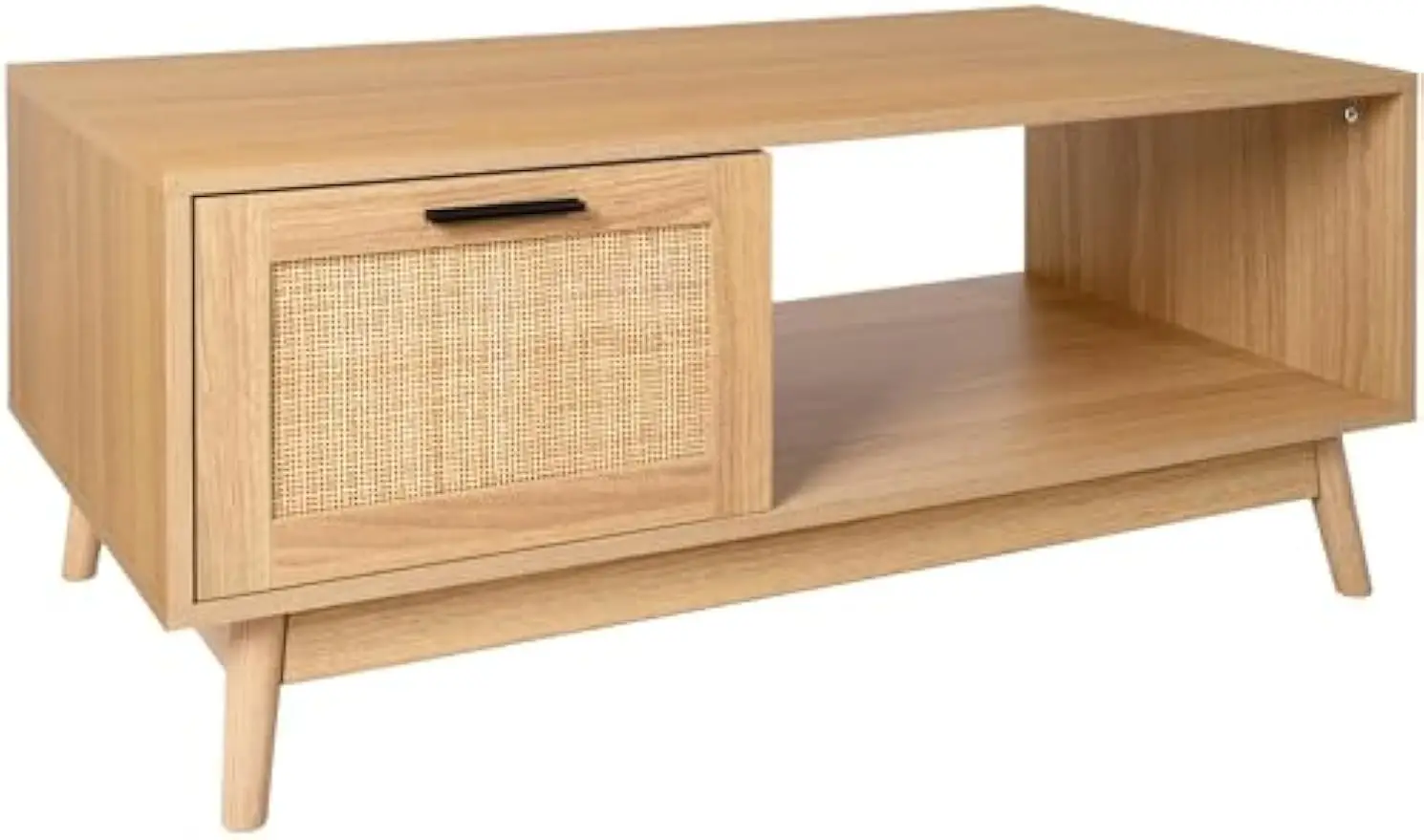
Specialized Connection Techniques
Danish coffee tables employ several specialized joinery methods to address particular construction challenges:
Slip and floating tenons provide the strength of traditional mortise and tenon joints while offering manufacturing advantages. Rather than carving a tenon directly from one piece, a separate tenon piece fits into mortises cut into both joining pieces. This approach proves especially valuable when connecting pieces at angles.
Dovetail joints create nearly unbreakable connections between perpendicular pieces. While most commonly used in drawer construction, decorative dovetails occasionally appear in table frameworks as visual elements that showcase the maker’s skill.
Finger joints interlock pieces with a series of rectangular projections and notches. These joints distribute stress across multiple connection points, creating exceptional strength while displaying a distinctive geometric pattern that complements Danish aesthetic principles.
Explore our collection of mid-century modern Danish coffee tables to see these joinery techniques applied in authentic pieces.
Modern Adaptations and Accessible Approaches
Contemporary makers honor traditional joinery while sometimes incorporating modern techniques:
Dowel reinforcement utilizes wooden pegs inserted into precisely drilled holes to align and strengthen joints. When executed properly with tight tolerances, doweled joints can approach the strength of traditional mortise and tenon construction.
Knockdown hardware allows for disassembly—important for shipping large pieces. Quality Danish-inspired designs incorporate these elements discreetly while maintaining clean lines and structural integrity.
Biscuit joints use oval-shaped wooden inserts (biscuits) glued into matching slots cut into joining pieces. This technique provides excellent alignment while adding strength to edge-to-edge connections in tabletops and panels.
What distinguishes quality modern adaptations from inferior imitations is attention to detail—precisely fitted components, strategic reinforcement, and connections designed to accommodate natural wood movement over time.
Signature Design Features: Construction Solutions for Danish Aesthetics
Tapered and Angled Elements
The graceful tapering of legs and supports defines the Danish coffee table silhouette, but achieving these elements requires sophisticated construction approaches:
Creating perfect tapers involves carefully controlled cutting angles and consistent material removal. Traditional craftspeople often use simple jigs with hand planes to achieve precise, matching tapers across all table legs. The taper typically begins a few inches below the joint with the table frame, preserving maximum structural strength at the critical connection point.
The challenge intensifies when joining these tapered elements to horizontal components. Specialized angled mortise and tenon joints ensure secure connections while maintaining visual lightness. Examining timeless elegance in teak coffee tables reveals how these tapered elements contribute to the floating quality that makes Danish designs so distinctive.
Sleek Edge Treatments
Edge profiles significantly influence both visual impression and tactile experience:
Pencil-roll edges feature subtle rounding that softens the transition between surfaces without appearing bulky. This profile requires careful sanding progression to achieve consistent curvature without flat spots.
Chamfers and bevels remove material at precise angles to reduce visual mass and create engaging light-catching edges. These treatments make thick materials appear thinner while adding sophisticated detail.
Sculpted edges occasionally appear on organic designs, requiring careful hand-shaping with specialized tools to achieve flowing contours that maintain consistent thickness.
These edge treatments reflect the Danish commitment to human-centered design—creating furniture that feels as good as it looks.
Distinctive Tabletop Construction
Danish coffee table tops employ several construction solutions to address both aesthetic and functional requirements:
Floating tabletop illusion results from recessed connection points or setback support structures that make the top appear to hover above the base. This design approach requires careful structural planning to maintain stability while preserving visual lightness.
Breadboard ends cap the tabletop’s exposed grain edges with pieces running perpendicular to the main boards. This technique prevents warping while adding visual refinement. Proper construction allows for seasonal wood movement through specialized joinery that permits slight expansion and contraction.
Veneer applications maximize the visual impact of premium woods. Quality Danish construction uses thick, stable veneers over dimensionally stable cores—creating durable surfaces with spectacular grain patterns that would be impossible or prohibitively expensive in solid wood.

Mid-Century Modern Solid Wood Coffee Tables, Mid-Century Modern Teak Coffee Tables
$879.95 Select options This product has multiple variants. The options may be chosen on the product pageMid-Century Modern Danish Coffee Tables, Mid-Century Modern Oval Coffee Tables, Mid-Century Modern Solid Wood Coffee Tables
$390.05 Select options This product has multiple variants. The options may be chosen on the product pageMid-Century Modern Glass Top Coffee Tables, Mid-Century Modern Glass Top Side & End Tables
$460.58 Select options This product has multiple variants. The options may be chosen on the product pageMid-Century Modern Glass Top Coffee Tables, Mid-Century Modern Vintage Coffee Tables, Mid-Century Modern Vintage Side & End Tables
$725.36 Select options This product has multiple variants. The options may be chosen on the product pageMid-Century Modern Oval Coffee Tables, Mid-Century Modern Solid Wood Coffee Tables
$679.56 Select options This product has multiple variants. The options may be chosen on the product pageMid-Century Modern Solid Wood Coffee Tables, Mid-Century Modern Walnut Coffee Tables
$501.53 Select options This product has multiple variants. The options may be chosen on the product page
Our collection of solid wood coffee tables demonstrates how these construction principles translate into beautiful functional pieces that stand the test of time.
Integrated Storage Elements
Danish coffee tables often incorporate thoughtful storage solutions without compromising clean lines:
Shelf construction requires careful consideration of support mechanisms. Rather than bulky brackets, Danish designs often use recessed supports, floating techniques, or integrated structural elements to maintain visual lightness.
Drawer building showcases exceptional woodworking skill. Dovetailed corners, smooth-gliding wooden runners, and precisely fitted components create storage that operates flawlessly for decades. The drawer becomes a furniture piece in its own right, often featuring solid wood construction throughout.
Material selection for these components typically maintains consistency with the primary structure, though occasionally contrasting woods appear as deliberate design elements.
Building Process: Creating an Authentic Danish-Inspired Coffee Table
Planning and Preparation
Success begins with thorough planning:
Creating or selecting an authentic design requires understanding core principles of identifying Danish-inspired coffee tables and their proportions. Classic Danish coffee tables typically maintain specific height-to-width ratios that balance visual lightness with practical functionality.
Developing scaled drawings with precise measurements proves essential. These plans should address not just overall dimensions but also joinery details, material thicknesses, and assembly sequence.
Lumber selection demands careful attention to grain patterns, color consistency, and moisture content. Quality Danish construction begins with properly dried wood (6-8% moisture content) that’s been acclimated to the workshop environment. This prevents future warping or joint failure.
The milling sequence establishes straight reference edges and faces before cutting pieces to final dimensions. This methodical approach ensures square components that will assemble accurately.
Component Fabrication
Crafting individual parts follows a strategic sequence:
Leg components typically come first, as they often require the most complex shaping and joinery. Creating identical tapered legs demands careful template work or jig setups to ensure consistency across all pieces.
Frame components follow, with precise joinery layout marking the critical connection points. Taking time to create accurate layout lines prevents costly errors during cutting.
Tabletop construction may involve edge-gluing solid boards, preparing veneered panels, or fabricating frame-and-panel assemblies depending on the specific design.
Throughout fabrication, dry-fitting components checks for proper fit before proceeding to the next stage. This methodical approach aligns with Danish coffee tables’ minimalist design philosophy where precision is essential.
Assembly Process
Bringing components together requires careful planning:
Complete dry assembly confirms all parts fit properly before applying adhesive. This crucial step reveals any adjustments needed before glue makes corrections impossible.
Glue selection matters significantly—traditional hide glue offers historical authenticity and repairability, while modern PVA glues provide convenience and moisture resistance.
Proper clamping techniques ensure joints close completely without distorting the assembly. Danish coffee tables often require specialized clamping approaches for angled components and complex shapes.
Assembly typically proceeds in subassemblies (base structure, top structure, drawers) before final integration of all components. This staged approach manages complexity and ensures quality at each step.
Finishing Touches
The final stages transform raw wood into furniture:
Surface preparation begins with careful scraping to remove any glue residue, followed by progressive sanding starting at medium grits (120-150) and working through fine grits (up to 320) for an exceptionally smooth surface.
Traditional Danish oil application involves multiple thin coats with light sanding between applications. This creates a protective finish that penetrates the wood rather than simply coating the surface.
Hardware installation comes last, ensuring precise alignment of any metal components, drawer pulls, or adjustable feet.

Care and Preservation: Maintaining Danish Coffee Table Beauty
Daily Maintenance
Preserving Danish coffee table beauty requires simple but consistent care:
Preventative measures make the biggest difference in long-term condition. Using coasters for drinks, avoiding direct sunlight exposure, and maintaining stable humidity levels (40-60%) prevents most common damage types.
Regular cleaning requires only a soft cloth, slightly dampened if necessary. Avoid commercial furniture polishes containing silicone, as these build up over time and can interfere with future refinishing.
Seasonal attention includes checking and tightening any loosening joints and applying fresh oil to areas showing dryness—typically once or twice yearly depending on your climate.
Restoration Techniques
When damage occurs, appropriate restoration preserves value:
Water rings often respond to gentle treatments like mayonnaise left overnight or careful buffing with 0000 steel wool and lemon oil rather than aggressive sanding.
Surface scratches in oil finishes can often be addressed by cleaning thoroughly and applying fresh oil to the affected area, allowing the finish to blend naturally.
Joint reinforcement might require carefully disassembling the connection, cleaning old glue, and regluing with proper clamping—a task sometimes best left to professional restorers for valuable pieces.
Professional restoration becomes appropriate when structural issues exceed basic repair capability or when dealing with particularly valuable pieces where mistakes could significantly impact value.
Design Legacy: Influential Designers and Construction Signatures
The construction techniques discussed throughout this article emerged from the work of master designers who established enduring standards of quality. Each major Danish furniture designer developed signature approaches to materials and joinery that informed their distinctive aesthetic.
Some designers became known for particularly elegant tapered leg profiles, while others developed innovative approaches to creating visual lightness through strategic material removal. Some pioneered industrial adaptation of traditional techniques, making quality design more accessible without sacrificing essential construction principles.
This legacy continues through contemporary designers who honor traditional construction methods while addressing modern needs. Today’s most respected makers maintain the core principles of quality joinery, appropriate material selection, and human-centered proportions—even as they explore new forms and functions.
Essential Terminology: Danish Design Woodworking Glossary
- Breadboard end: Perpendicular board attached to tabletop edge to prevent warping
- Danish oil: Penetrating wood finish that enhances grain without building thick film
- Dovetail joint: Interlocking trapezoidal pins and tails creating strong connections
- Finger joint: Series of interlocking rectangular cuts joining pieces at corners
- Floating tenon: Separate piece fitting into mortises cut in both joining components
- Mortise: Cavity cut to receive a tenon in woodworking joints
- Patina: Natural change in wood appearance from aging and use
- Pencil-roll edge: Subtle rounded profile resembling pencil circumference
- Quarter-sawn: Lumber cut perpendicular to growth rings for stability and figure
- Slip joint: Connection allowing controlled movement between components
- Tenon: Projection cut to fit into a mortise creating a strong wood joint
- Veneer: Thin wood layer applied over substrate for appearance and stability
Contemporary Relevance: Why Danish Construction Principles Endure
The construction principles that define Danish coffee tables have proven remarkably enduring precisely because they address fundamental needs rather than following trends. The emphasis on honest materials, functional design, and quality craftsmanship creates pieces that remain relevant across changing design landscapes.
In today’s homes, these pieces continue to serve as functional art—providing practical surfaces while enhancing spaces with their warm wood tones and clean lines. Understanding the construction quality behind these designs helps appreciate both their beauty and value.
At Hearth Forms, we celebrate these timeless principles through our carefully curated collections. Each piece represents not just a furniture item but a connection to a rich tradition of craftspeople who believed furniture should be both beautiful and built to last for generations.
The enduring craft of Danish coffee table construction reminds us that in a world of disposable goods, quality and integrity in materials and methods still matter—perhaps now more than ever.

